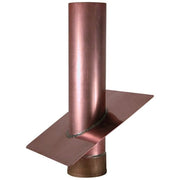Roof Jacks
Why Do I Need Roof Jacks?
When you have pipes, vents, or other components that need to pass through your roof, proper waterproofing becomes essential.
Roof jacks serve as protective barriers that prevent water infiltration where these elements penetrate your roofing material. Without proper flashing protection, even a small gap around a pipe or vent can lead to significant water damage, affecting your roof structure, insulation, and interior spaces.
Beyond water protection, roof jacks also help maintain proper ventilation system functionality. They elevate vent pipes above snow levels in colder climates and ensure optimal airflow for your home's ventilation systems. This proper ventilation helps prevent moisture buildup in your attic space, reduces energy costs, and extends the life of your roofing materials.
Types of Roof Jack Vents
The material you choose for your roof jack vents significantly impacts their performance and longevity. Each metal option offers distinct advantages:
Aluminum
- Lightweight and naturally corrosion-resistant
- Cost-effective while maintaining good durability
- Ideal for most residential applications
- Compatible with most roofing materials
Copper
- Exceptional durability with a lifespan of 50+ years
- Develops a distinctive patina over time
- Superior resistance to environmental factors
- Premium aesthetic appeal that enhances property value
Galvanized Steel
- Strong and impact-resistant
- Zinc coating provides excellent rust protection
- Cost-effective for commercial applications
- Suitable for areas with severe weather conditions
Stainless Steel
- Maximum durability and corrosion resistance
- Maintains its appearance without weathering
- Ideal for coastal environments
- Minimal maintenance requirements
Choosing a Metal Roof Jack
Selecting the right metal roof jack involves considering several key factors:
- Pipe Size Compatibility: Consider the diameter of the pipe or vent that needs flashing. Roof jacks typically come in sizes ranging from 1.5 to 6 inches in diameter. Ensure you measure your pipe's exterior diameter accurately for proper fitting.
- Roof Pitch: Your roof's slope affects which model you need. Most manufacturers offer roof jacks designed for specific pitch ranges. A proper fit ensures optimal water drainage around the flashing.
- Climate Considerations: Consider your local weather conditions when selecting materials. Areas with heavy snowfall benefit from taller roof jacks, while coastal regions require more corrosion-resistant materials like stainless steel or copper.
- Installation Method: Some metal roof jacks come with integrated base flanges for easier installation, while others may require additional flashing kits. Consider your installation expertise or contractor preferences when making your selection.
- Code Requirements: Check local building codes for specific requirements regarding flashing materials and installation methods. Some jurisdictions may have particular specifications for certain applications.











